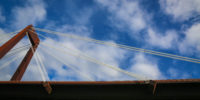My primary research interest is at the interface of geotechnical and structural earthquake engineering, studying the response mechanisms of sub-and superstructure elements and systems. My current and past research projects include the experimental studies and numerical evaluation of deep foundation systems, underground structures and embankment systems, as well as the response of structural components to static and dynamic loading via large scale testing (field/lab), model scale testing (centrifuge/shake table) and analytical-numerical frameworks. I am also interested in the development of innovative instrumentation schemes and sensor technology applicable to soil structure interaction (SSI) studies. My research in deep foundations also includes the exploration of high performance materials that reduce the carbon footprint in conventional foundation design.
I am furthermore interested in studying the influence of SSI on structural components and systems through case and field studies, model/large-scale testing and numerical and parametric simulations. Studies pertaining to the structural response behavior due to ground excitation include the assessment of building components (e.g., moment resisting frame components and cladding systems), as well as the investigation of retrofit and strengthening mechanisms for structurally damaged components.




